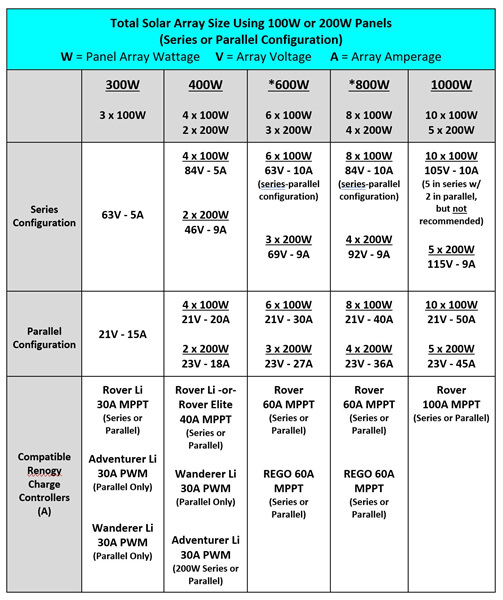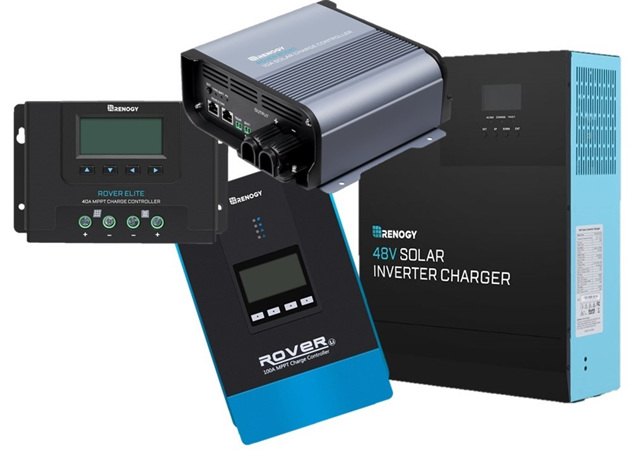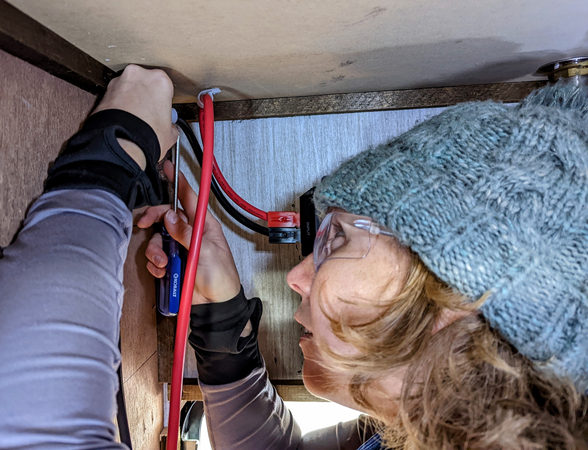Adding Solar Panels to Existing System | Is it Feasible?
Can you add solar panels to an existing system? The short answer is, most likely yes. The longer answer depends on why you want to add more solar panels. Narrowing this down will help determine if you can add to, or need to simply replace, your existing panels.
If any of the following statements sound like your situation, this blog will walk you through a few of the considerations for how to add more solar panels to an existing system.
- You aren’t able to get enough solar gain to adequately replenish your battery bank.
- When traveling in your RV during the spring, fall, or winter (or at higher latitudes during these seasons), you find that you don’t have enough solar gain.
- You are seeking to run more electrical appliances than initially calculated.
- You often need to park your rig in the shade to keep it cool, but still want to charge the battery bank with solar while camping.
- You’ve added battery capacity to your RV / boat / off-grid home and now you need to add more panels.
- Climate change has impacted the amount of sun in your area – more storms, more clouds, more snow, etc.
How to Add Solar Panels to Existing System
Expanding Solar System with Roof Top Panels
If you have enough room on the roof of your RV (or off-grid home) to add panels to your existing system, here are some important considerations before diving in and purchasing more panels. If it’s been awhile since you designed your system or someone else installed it for you, this blog will help you review some of the terminology and this interactive solar system sizing worksheet will walk you through how much solar you may need to add to meet your needs.
1.Wattage Equivalency & Array Configuration
When you add panels to an existing system, it’s important to use the same wattage of panels that are currently on your roof. Don’t mix and match panel wattages. So, if you already have 100W panels, purchase additional 100W panels; if you have 200W panels, stick with more 200W panels.
Keep in mind, if you add panels to an array that is set up in parallel, you’ll be adding additional amperage to your system. If your panels are already set-up in series, you’ll be adding additional voltage with additional panels. This is important to note because you want to make sure that your wiring, fusing, and charge controller are set-up to accommodate this extra amperage and/or voltage. If you find that your wiring, fuses, and/or charge controller are too small, try to change the array configuration to accommodate the additional voltage/amperage passing through the wiring. If rearranging doesn’t work for your system, you’ll need to increase your wire gauge, fuse size, and the charge controller to enhance the safety of your overall system. See chart below for details about parallel vs. series for various sized systems.

2. Age of Panels
The efficiency of solar panels decreases with age, so take this into account when expanding a solar system. If your existing panels are 15-20 years old, you’ll probably want to upgrade to more modern, higher efficiency monocrystalline panels, instead of just adding new ones into the array.
3.Charge Controller, Wire Gauge, & Fuse Size
To determine the size and specs for each of these items, please refer to this blog - Everything You ever Wanted to Know about Renogy Charge Controllers for details about choosing and sizing a solar charge controller, wiring, and fusing.

Adding Solar Panels to Existing System with Foldable Solar Suitcase(s)
If you do not have room on the rooftop to add panels of the same wattage, or you simply want the flexibility of putting out a portable panel during lower solar days (for additional surface area) or when your rig is parked in the shade (to keep it cooler), you can easily add a solar suitcase into your system. We’ve been doing this on our travel trailer for many years with great success! Watch our step-by-step installation video for details on how to combine a solar suitcase with a rooftop system.
Below are some considerations for integrating a solar suitcase into your existing solar system.
1.Array Configuration, Wattage Equivalency & Charge Controller Size
Option 1: If you want to integrate a solar suitcase into the system through an existing charge controller, you must set up your panels in parallel and all panel wattages need to be the same (e.g., all 100W or all 200W, etc.). For this option, you’ll want to purchase a 100W (or 200W) solar suitcase WITHOUT a charge controller.
EXAMPLE:
- Existing System: 2 x 12V 200W Rigid Panels (in parallel configuration) = 400W (22.10* @ 12V) + 30A Charge Controller. *Short circuit amperage for 200W panel = 11.05A.
- Add to System: 1 x 12V 200W Solar Suitcase w/o charge controller (11.05A @ 12V) which will be wired into the existing charge controller.
- Outcome & Question: Can your existing charge controller handle 33.15A @ 12V? Check the specs! In this example, the 30A charge controller is NOT large enough to handle the additional solar. You’ll need to increase the size of your charge controller or purchase a solar suitcase with an attached charge controller and wire it directly to the battery. Refer to this blog for details about choosing and sizing a solar charge controller, wiring, and fusing. Or, see option #2 below for an alternative set-up.
Option 2: If your rooftop panels are set-up in series, you can integrate a solar suitcase WITH an attached charge controller, then wire this portable panel directly to the battery (or use the provided alligator clips). Doing this essentially creates two separate systems (one on the roof, one on the ground), both feeding the same battery bank. In this scenario, the panel wattages can be different, if needed, because 2 different charge controllers are handling the voltage/amperage separately.
EXAMPLE:
- Existing System: 2 x 12V 200W Flexible Panels (in series configuration) = 400W (11.05A* @ 24V) + 30A charge controller
- Add to System: 1 x 12V 200W Solar Suitcase with attached charge controller wired directly to the battery.
- Outcome: You’ve created 2 separate systems and each charge controller is adequate for each set of panels, so you’re all set!
2. Wire Gauge & Fuse Size
- In addition to making sure the charge controller is large enough for your new system, you’ll want to make sure your wiring and fuses can handle the increased voltage/amperage from the new panel(s). Note: Most RVers use a special extension cord in order to put the portable panel out into the sun while their rig is parked in the shade. For a 200A solar suitcase on a 20ft extension cord, you’ll want to make sure you purchase two (1 for positive and 1 for negative) 10AWG Extension Cords with MC4 connectors.
Cost to Add Solar Panels to Existing System
Compared to batteries and inverters, solar panels are the least expensive components of your existing system. If the other components are sized appropriately for your additional solar power, this can be a cost effective way to increase capacity. However, if your solar array plans exceed the capacity, you might be looking at a full system upgrade.
DIY Quality Uncertain?
Many used RV’s come with a DIY solar panel system already installed. This might have even been a buying factor when you purchased it. But, was it a quality job?
Our friend Ben, bought a classic used truck camper (cab over) with a 200W solar panel system already installed on the roof. While this system was adequate for the previous owner, it wasn’t quite up to the job that Ben had in mind for his full-time RV lifestyle. When he began looking at ways to increase the capacity, he was disheartened to find that the solar wiring and components were barely robust enough to handle their current capacity, let alone for the plans he had. It’s always a good idea to check the size of wires and fuses, the capacity of the charge controller, and the size of the inverter, before you decide to add more solar panels to an existing system.

Adding Additional Panels to a Home Solar Array
We have some friends who increased their solar array within one year of moving into their solar powered home, because they realized that not only did they have a greater need, but that their location was ideal for more solar. It was a no-brainer to upsize their original system for greater capacity.
Not everyone will find themselves in the same situation, so here’s a great resource to determine if you should add panels to your home solar array. It’s also important to note that It is unlikely that simply adding more panels to an existing system will qualify for the 30% federal solar tax rebate as qualifying systems need to be installed and working as one complete system.
Is Bigger Always Better?
Not every system will need to be upgraded, in fact with a few key power saving strategies, you may be able to keep your smaller solar system running for years. So take a close look at your energy needs, how you use your system, and how you intend to use it over the next few years before you make the extra investment in additional panels.
In 2012, Shari Galiardi & David Hutchison left behind careers and a comfortable home in North Carolina to travel with the vintage camper trailer they lovingly restored, outfitted with solar, and named "Hamlet." What began as a short break from careers and responsibility quickly turned into a love affair with roadlife. They have parlayed their higher education backgrounds, desire for life-long learning, and thirst for adventure travel into writing, photography, video production, and public speaking gigs from coast to coast. Known to their friends as simply Shari & Hutch, you can learn more about their full-time, solar-powered adventures on their website at freedominacan.com. Or, follow them on Facebook, Instagram, and YouTube as “Freedom in a Can, LLC.”

Related articles:
Bifacial Solar Panels: Disadvantages And Advantages
Most Efficient Solar Panels: Harnessing The Sun For Maximum Savings
How To Get Free Solar Panels From The Government In 2023








